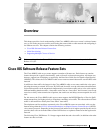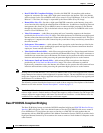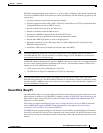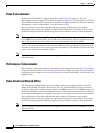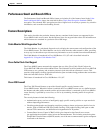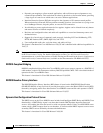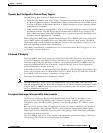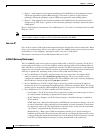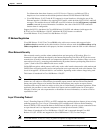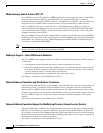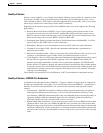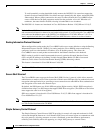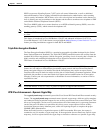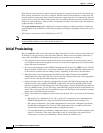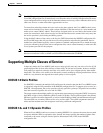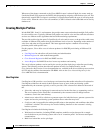
1-9
Cisco uBR924 Software Configuration Guide
OL-0337-05 (8/2002)
Chapter 1 Overview
Cisco IOS Software Release Feature Sets
For information about these features, see H.323 Version 2 Support, available on CCO at
http://www.cisco.com/univercd/cc/td/doc/product/software/ios120/120newft/120t/120t5.
• Cisco IOS Release 12.1(2)T adds H.323 support for virtual interfaces, allowing the use of the
Ethernet interface’s IP address for outgoing H.323 traffic, which includes H.225, H.245, and RAS
messages. This enables the use of VoIP traffic over VPN solutions. See the h323-gateway voip bind
srcaddr command for more information. In addition, the value of the H.225 TCP connection
timeout timer is configurable.
Support for H.323 is introduced in Cisco IOS Release 12.0(4)XI1 and enhanced with support for
H.323v2 in Cisco IOS Release 12.0(5)T. Additional H.323v2 features are added in
Cisco IOS Release 12.1(1)T and Cisco IOS Release 12.1(2)T.
IP Address Negotiation
Cisco IOS Release 12.1(4)T for Cisco uBR900 series cable access routers adds support for the
ip address docsis command on the cable interface. Previous releases used the ip address dhcp and ip
address negotiated command for this purpose, but these commands cannot be used on cable interfaces.
IPsec Network Security
IPsec network security provides robust authentications and encryption of IP packets. IPsec is a
framework of open standards developed by the Internet Engineering Task Force (IETF) for the secure
transmission of sensitive information over unprotected networks such as the Internet. IPsec acts at the
network layer (Layer 3), protecting and authenticating IP packets between participating IPsec devices
(“peers”) such as the Cisco uBR924 cable access router.
Unlike BPI encryption, which protects traffic only on the cable interface between the cable modem and
CMTS, IPsec encryption provides end-to-end protection across open networks such as the Internet. Two
levels of encryption—56-bit and 168-bit—are available, depending on the software image being used.
This feature is introduced in Cisco IOS Release 12.0(5)T.
Note Cisco IOS images with strong encryption (including, but not limited to, 168-bit [3DES] data encryption
feature sets) are subject to United States government export controls and have limited distribution.
Strong encryption images to be installed outside the United States may require an export license.
Customer orders may be denied or subject to delay due to United States government regulations. When
applicable, the purchaser or user must obtain local import and use authorizations for all encryption
strengths. Contact your sales representative or distributor for more information, or send an e-mail to
export@cisco.com.
Layer 2 Tunneling Protocol
Layer 2 Tunneling Protocol (L2TP) is an IETF standard that combines the best features of two existing
tunneling protocols: Cisco’s Layer 2 Forwarding (L2F) and Microsoft’s Point-to-Point Tunneling
Protocol (PPTP). L2TP extends the Point-to-Point Protocol (PPP) to provide a secure connection across
an open network and is an important component for virtual private networks (VPNs).
This feature is introduced in Cisco IOS Release 12.0(5)T and is supported through Cisco IOS
Release 12.1(2)T. L2TP is not supported in Cisco IOS Release 12.1(3)T or later images.
Note Cisco IOS Release 12.1(5)T, 12.2(2), or greater is required to support GRE IP tunnels.



